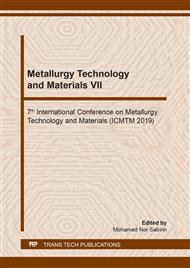[1]
N. Tao, L. Jia, and H. Zhou, Anti-fungal activity of Citrus reticulata Blanco essential oil against Penicillium italicum and Penicillium digitatum,, FOOD Chem., vol. 153, no. November 2011, p.265–271, (2014).
DOI: 10.1016/j.foodchem.2013.12.070
Google Scholar
[2]
A. H. Mossa, Review Article Green Pesticides : Essential Oils as Biopesticides in Insect-pest Management,, J. Environ. Sci. Technol., vol. 9, no. 5, p.354–378, (2016).
DOI: 10.3923/jest.2016.354.378
Google Scholar
[3]
C. Ciprian and M. Ignat, Polymeric microcapsules for cosmetic applications , based on Lemon essential oil ( Citrus Limon ) Polymeric Microcapsules For Cosmetic Applications , Based On Lemon Essential Oil ( Citrus Limon ),, No. January, (2015).
DOI: 10.3403/02946982
Google Scholar
[4]
A. M. S. Ritaro Matsuura, Hiroyuki Ukeda, Tyrosinase Inhibitory Activity of Citrus Essential Oils,, p.2309–2313, (2006).
DOI: 10.1021/jf051682i
Google Scholar
[5]
R. Chaiklahan, N. Chirasuwan, V. Loha, and B. Bunnag, Lipid and fatty acids extraction from the cyanobacterium Spirulina,, vol. 34, p.299–305, (2008).
DOI: 10.2306/scienceasia1513-1874.2008.34.299
Google Scholar
[6]
N. T. M. Tu, L. X. Thanh, A. Une, H. Ukeda, and M. Sawamura, Volatile constituents of Vietnamese pummelo , orange , tangerine and lime peel oils,, p.169–174, (2002).
DOI: 10.1002/ffj.1076
Google Scholar
[7]
T. T. Hien, N. Phu, T. Nhan, D. T. Nguyen, V. T. T. Ho, and L. G. Bach, Optimizing the Pomelo Oils Extraction Process by Microwave-Assisted Hydro-Distillation Using Soft Computing Approaches,, vol. 279, p.217–221, (2018).
DOI: 10.4028/www.scientific.net/ssp.279.217
Google Scholar
[8]
I. K. Shakir and S. J. Salih, Extraction of Essential Oils from Citrus By-Products Using Microwave Steam Distillation,, vol. 16, no. 3, p.11–22, (2015).
Google Scholar
[9]
A. Subramanian, S. Ananthan, M. Vignesh, and S. P. S. Bharathi, Extraction of Grapefruit Essential Oil from Grapefruit Peels,, vol. 74, p.29–33, (2014).
Google Scholar
[10]
S. O. Giwa, Utilizing orange peels for essential oil production,, no. January, (2018).
Google Scholar
[11]
K. Jalgaonkar, R. K. Pal, and G. Jha, Effect of species and particle size on essential oil yield of citrus peel ( Citrus spp ),, no. December, (2013).
Google Scholar
[12]
M. Mahendera, Extraction and Characterization of Essential oil of Sweet Lime ( Citrus Limetta Risso ) peel using Microwave-assisted Hydrodistillation,, vol. 4, no. 11, p.51–55, (2014).
Google Scholar
[13]
J. E. Cacace and G. Mazza, Mass transfer process during extraction of phenolic compounds from milled berries,, J. Food Eng., vol. 59, no. 4, p.379–389, (2003).
DOI: 10.1016/s0260-8774(02)00497-1
Google Scholar
[14]
B. E. Richter et al., Accelerated solvent extraction : A technique for sample preparation Accelerated Solvent Extraction : A Technique for Sample Preparation,, no. January, (1996).
DOI: 10.1016/b978-0-12-381373-2.00047-8
Google Scholar
[15]
X. Yu, A Novel Process for the Aqueous Extraction of Linseed Oil Based on Nitrogen Protection A Novel Process for the Aqueous Extraction of Linseed Oil Based on Nitrogen Protection,, no. June, (2016).
DOI: 10.19026/ajfst.9.1974
Google Scholar
[16]
W. Abdelmoez, E. Ashour, S. M. Naguib, and A. Hilal, Kinetic and Thermodynamics studies for Castor Oil Extraction Using Kinetic and Thermodynamics studies for Castor Oil Extraction Using Subcritical Water Technology,, no. May, (2016).
DOI: 10.5650/jos.ess15298
Google Scholar
[17]
N. Sulaiman, M. I. Idayu, A. Z. Ramlan, M. N. Fashya, A. N. N. Farahiyah, and J. Mailina, Effects Of Extraction Methods On Yield And Chemical Compounds Of Gaharu ( Aquilaria Malaccensis ),, vol. 27, no. 3, p.413–419, (2015).
Google Scholar
[18]
M. Chutia, P. D. Bhuyan, M. G. Pathak, T. C. Sarma, and P. Boruah, LWT - Food Science and Technology Antifungal activity and chemical composition of Citrus reticulata Blanco essential oil against phytopathogens from North East India,, LWT - Food Sci. Technol., vol. 42, no. 3, p.777–780, (2009).
DOI: 10.1016/j.lwt.2008.09.015
Google Scholar
[19]
M. Viuda-martos, Y. Ruiz-navajas, J. Fernández-lópez, and J. Angel, Journal of Essential Oil Bearing Plants Chemical Composition of Mandarin ( C . reticulata L .), Grapefruit ( C . paradisi L .), Lemon ( C . limon L .) and Orange ( C . sinensis L .) Essential Oils,, no. August 2014, p.37–41.
DOI: 10.1080/0972060x.2009.10643716
Google Scholar
[20]
M. Sawamura, N. Thi, M. Tu, Y. Onishi, and E. Ogawa, Characteristic Odor Components of Citrus reticulata Blanco ( Ponkan ) Cold-pressed Oil Characteristic Odor Components of Citrus reticulata Blanco ( Ponkan ),, no. July 2014, p.37–41.
DOI: 10.1271/bbb.68.1690
Google Scholar
[21]
M. Lota, D. D. R. Serra, H. Tomi, and J. Casanova, Chemical variability of peel and leaf essential oils of 15 species of mandarins,, vol. 29, (2001).
DOI: 10.1016/s0305-1978(00)00029-6
Google Scholar
[22]
Z. boughendjioua Boughendjioua, Hicham, Research Article Chemical Composition and Biological Activity of Essential Oil of Mandarin ( Citrus reticulata) Cultivated in Algeria.,, vol. 44, no. 40, p.179–184, (2017).
Google Scholar
[23]
N. S. Dosoky and W. N. Setzer, Biological Activities and Safety of Citrus spp . Essential Oils,, no. Table 1, p.1–25, (2018).
DOI: 10.3390/ijms19071966
Google Scholar
[24]
M. Saeidi and S. Moharramipour, Insecticidal and repellent activities of Citrus reticulata , Citrus limon and Citrus aurantium essential oils on Callosobruchus maculatus Insecticidal and repellent activities of Citrus reticulata , Citrus limon and Citrus aurantium essential oils on Callosobruchus maculatus,, no. September, (2017).
DOI: 10.1007/bf01941044
Google Scholar


